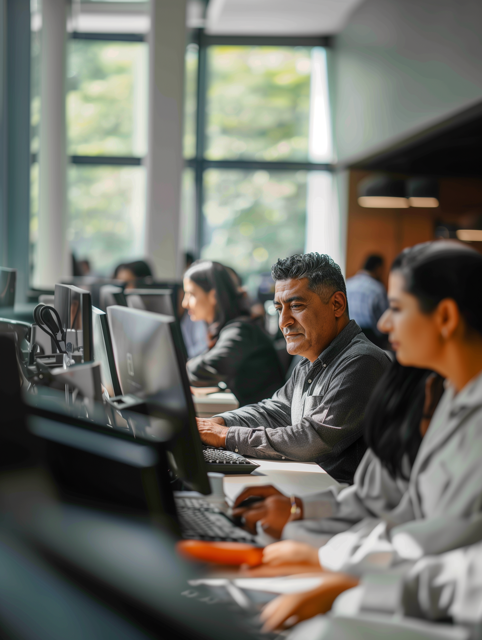Published May 31, 2024
What is a 360 customer view?

Especially as organizations become more and more digitized, there are all kinds of data to consider, including from your customers. Customers have many interactions with your business, on your website, through social media, and more, which creates data points. But how do you fully leverage that information?
A 360 customer view empowers organizations to gain deep insights into customer behaviors, preferences, and interactions across various channels. It’s a holistic perspective that gives businesses the ability to personalize the customer experience and make more informed decisions.
What is a 360 customer view?
A 360 customer view is a centralized, comprehensive profile of each customer, created by integrating data from all customer touchpoints and interactions. It consolidates information from various sources, like your different internal departments, into a single, cohesive view. In other words, this takes fragmented data from all of your data points from customers and makes it actionable for businesses.
Some of the key components of this resource include:
- Data integration: Combining data from various sources such as CRM systems, social media, email interactions, and transactional records to create a unified profile.
- Customer interaction tracking: Monitoring and recording all customer interactions across different channels to understand the entire customer journey.
- Analytics and intelligence: Using advanced analytics to get actionable insights from the integrated data, enabling more informed decision-making and strategic planning.
With these capabilities, businesses can do so much more for their customer base. This broader understanding of customers not only improves individual interactions but also fosters long-term loyalty and growth, which makes your business all the more sustainable.
Benefits of a 360 customer view
A 360-degree customer view can really impact several customer-facing departments within an organization. For example, marketing teams, sales departments, operation teams, and customer service representatives are all being shaped by this approach to customer insights. As these jobs leverage this resource, the resulting data is becoming more and more irreplaceable.
Customer service
One of the most notable perks is the improvement in customer service. With such a complete picture of each customer’s history and preferences, customer service representatives can provide more personalized and efficient support. This deeper understanding allows them to address issues promptly and effectively, resulting in higher customer satisfaction and loyalty.
Marketing
Personalized marketing strategies are another key benefit. By having access to detailed customer data, marketing teams can create highly targeted campaigns that resonate with individual customers. Understanding their behaviors and preferences allows marketers to craft messages that are relevant and engaging, which leads to increased conversion rates and customer retention. This level of personalization can set a business apart in a competitive market, fostering stronger connections with customers.
Decision-making
Improved decision-making is also a big advantage of a 360 customer view. When all customer data is integrated and accessible in one place, decision-makers have a holistic understanding of the customer base. Whether it’s identifying new market opportunities, optimizing product offerings, or honing customer experiences, a 360 customer view provides the necessary information to make sound judgments.
Predictive analytics
Predictive analytics is a powerful tool made possible by a 360 customer view. By analyzing integrated data, businesses can identify patterns and trends that help predict future customer behaviors. This foresight allows companies to proactively address potential issues, tailor offerings to meet emerging needs, and stay ahead of the competition. The exciting bit is, that these benefits lead to other business perks like increased revenue and growth.
Cross-departmental collaboration
Finally, a 360 customer view fosters cross-department customer alignment. When all departments have access to the same customer data, it promotes collaboration and consistency. This alignment ensures that every team works towards the same goals, providing a seamless and cohesive customer experience. By breaking down silos and encouraging a unified approach, businesses can maximize how they meet customer needs.
Challenges of the 360 customer view
Implementing a 360 customer view can transform how businesses perceive and interact with their customers, but it comes with some common challenges.
Data chaos
Customer data comes from a variety of sources, such as emails, social media, in-store interactions, call center logs, and more. Integrating this data into a unified system can be a daunting task. Each source often has different formats and structures, making it difficult to organize and consolidate the data effectively. Without the right technology and processes, businesses might find themselves overwhelmed by the sheer volume and diversity of data, leading to potential inaccuracies and inefficiencies.
Identity resolution
Once data is collected, resolving duplicate records into a single, accurate customer profile is essential. Customers may have different identifiers across platforms—like varying email addresses or names due to typos. This complexity requires sophisticated identity resolution techniques, often powered by machine learning algorithms, to accurately match and merge these disparate records. Failing to resolve identities correctly can result in duplicate profiles, which undermines the effectiveness of the 360 customer view.
Data privacy and security
Data privacy laws such as the GDPR in the EU and the CCPA in California impose strict regulations on how customer data can be collected, stored, and used. Ensuring compliance with these regulations is a significant challenge, requiring robust security measures and transparent data-handling practices. Companies must implement encryption, access controls, and regular audits to protect customer data and maintain trust.
Resistance to change
Transforming existing processes to accommodate a new, integrated customer data system can be a big task, too. Employees accustomed to legacy systems and workflows may be hesitant to adopt new technologies. This resistance can stem from a lack of understanding of the benefits, fear of job displacement, or simply the discomfort associated with learning new systems. Effective change management strategies, including clear communication, training, and demonstrating the long-term advantages, can certainly help.
Integration challenges
To work a 360 customer view into your other relevant applications can be complex and resource-intensive, especially with legacy systems. Data from various sources may have incompatible formats, leading to technical challenges. An Integration Platform as a Service (iPaaS) helps manage and streamline these connections, but significant effort and coordination are still required to ensure seamless data flow and accessibility across departments.
How iPaaS is critical to achieving a 360 customer view
Having a unified profile is one of the most important aspects of 360-degree customer view, and as mentioned, iPaaS is one of the best ways to go about it correctly. iPaaS platforms like Celigo provide the necessary infrastructure to streamline data integration and offer real-time data synchronization.
Streamlining data integration
iPaaS platforms can provide you with seamless data flow, allowing businesses to connect various applications and data sources effortlessly. This integration ensures that all relevant departments have access to up-to-date and comprehensive customer data. By removing roadblocks that prevent data sharing, iPaaS enables a holistic view of customers. This makes collaboration and decision-making across the organization much more impactful.
Real-time data synchronization
Maintaining up-to-date customer information is crucial for delivering personalized and timely customer experiences. iPaaS ensures real-time data synchronization, meaning customer profiles are continuously updated as new data comes in from various touchpoints.
This allows businesses to respond quickly to customer needs and preferences—which boosts overall engagement and satisfaction. With platforms like Celigo, companies can achieve a dynamic and accurate 360 customer view, helping them make more informed decisions and stronger customer relationships.
How to implement a 360 customer view
Developing a 360 customer view requires strategic planning and the right tools. Here’s what businesses looking to better understand their customers can do.
Starting with the right technology foundation
The first step is to invest in a sophisticated integration platform that can grow with your business. An iPaaS like Celigo offers flexible, scalable solutions that adapt to your business needs. This way, as your data requirements expand, your platform can handle the increased load without compromising performance.
Celigo is especially equipped to help with its ability to connect a wide array of applications and systems. Essentially, it makes data integration smoother and more efficient. Its flexibility allows businesses to unify disparate data sources, providing a single, coherent view of each customer. By choosing a platform like Celigo, businesses can ensure that all customer data is accessible, up-to-date, and ready to be analyzed.
Fostering a data-driven culture
To create a 360 customer view, it isn’t just about technology—it requires building a data-driven culture within your organization. Encourage collaboration between departments whenever possible. When these teams share insights and data, they can work together to improve the customer experience altogether.
Once data is integrated and accessible, you can use these insights to drive ongoing improvement. Regularly analyze customer data to identify trends, preferences, and potential issues. Leverage this information to refine marketing strategies, improve customer service, and optimize operations. By continuously learning and adapting, businesses can stay ahead of customer needs and expectations.
Know your customers, strengthen your business
When you take a closer look at the customer journey and take full advantage of the data, there are so many possibilities for both your customer experience and business success.
Remember that to achieve a 360 customer view, you have to start by selecting the right technology and fostering a data-driven culture. A scalable integration platform like Celigo can seamlessly unify diverse data sources so that all relevant departments have access to the same extensive customer insights. This supports personalized marketing, efficient operations, and improved customer service.
Encouraging collaboration across departments and leveraging these insights for continuous improvement also helps businesses stay ahead of customer needs (and ahead of competitors). With its flexibility and robust capabilities, Celigo is an ideal choice for achieving a holistic, dynamic understanding of customers that your entire organization can use.
Contact us today to see how the Celigo platform can help you leverage your customer insights!




